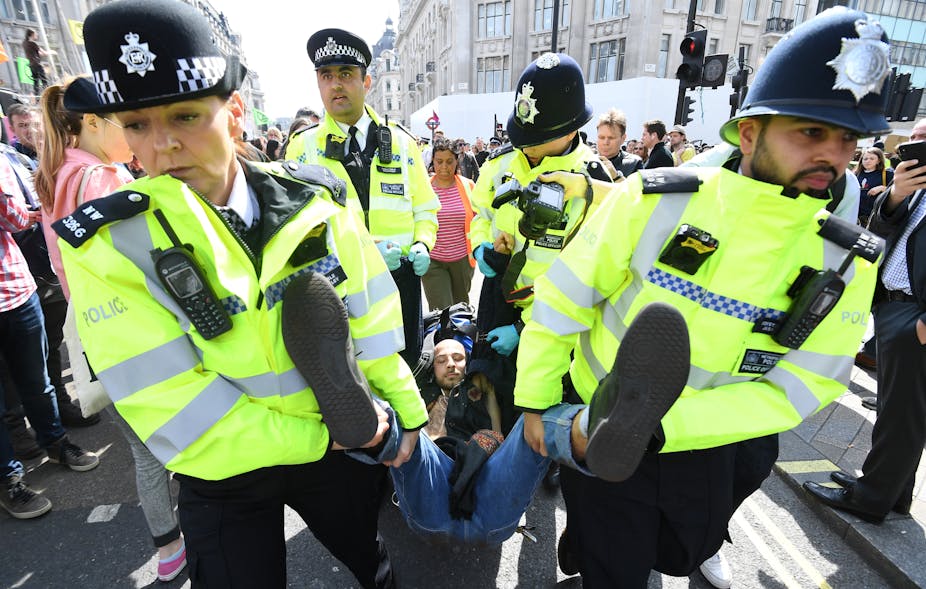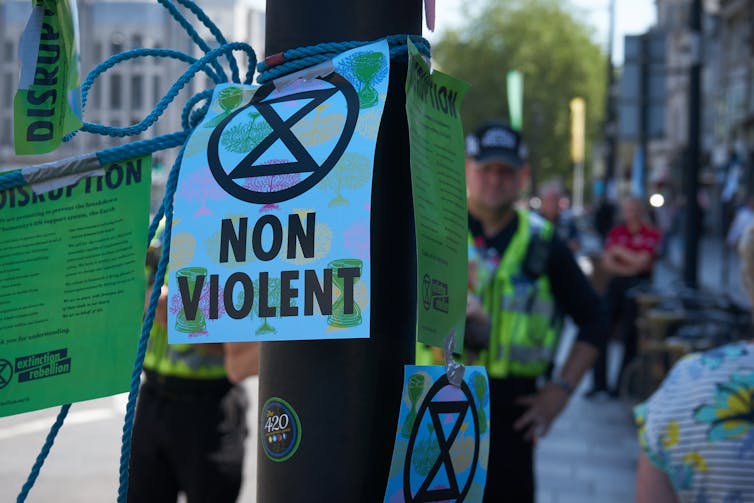Insulate Britain is a campaign group urging government action on greenhouse gas emissions and fuel poverty in the country’s housing stock. Their methods have recently landed them in the news, as activists blocked parts of the M25 – the motorway surrounding London – by sitting on slip roads and in the carriageway until their removal by police.
The long delays their protests caused drew outrage from motorists and much of the media that reported it. So what is the purpose of this kind of disruption, made popular in recent years by Extinction Rebellion (XR)?
The American sociologist Charles Tilly argued that all protest actions were what he called WUNC displays: shows of worthiness, unity, numbers and commitment. The goal was not to stop or make something happen directly, but to demonstrate the strength and appeal and values of the protesters, so that both those in power and the general public would listen to their message.
Direct action groups tend to be slightly different from traditional social movements: their actions typically carry higher risks, and they tend to have fewer organisational resources. While they are very committed, being “respectable” isn’t necessarily so important, and the actions are typically carried out by relatively small numbers of people. Creating disruption helps make up for these shortcomings.
Novelty and attention
Protest is the language of people denied access to power – it is designed to draw attention, to be seen and heard. It is much more likely for protesters to achieve something if they inconvenience others in the process, rather than (as more established groups tend to do) leading a march or a demo. Many activists in Britain drew that lesson from the massive anti-Iraq war protests of 2003, which mobilised so many people and yet achieved little.
Recently, researchers have shown this to be true by comparing various kinds of protest over the past decade. Strikes, sit-ins, occupations and blockades have proven more likely to achieve some degree of success than less disruptive protests such as marches, demos or petitions.
One reason for the efficiency of disruption is that it is much more likely to provide press coverage, particularly when it is novel. It’s instructive to compare the Insulate Britain protests with the recent Extinction Rebellion protests. In April 2019, XR were able to garner widespread media and political attention by occupying central London for nearly two weeks. Since then however, doing the same thing has brought diminishing returns: the police are better prepared, the actions are less disruptive, they mobilise fewer people, and the media has turned elsewhere.
Yet people stopping traffic on the M25 has attracted attention. And the small group of activists have managed to get their demands – insulate all social housing by 2025 and all homes by 2030 – printed in national newspapers. Their clear demands are an evolution of XR’s preference for leaving details of what policies are needed to tackle climate change to a future citizens’ assembly.

Irin-k/Shutterstock
Is annoying people worthwhile?
Critics say that blocking roads hurts vulnerable people. In this case, talk radio hosts highlighted delays to one girl’s taxi journey to her special needs school. In the case of anti-fracking activists who blocked the A583 in Lancashire in July 2017, the trial judge argued that the inconvenience caused – the police had to set up a contraflow – justified sending three of them to jail on a public nuisance charge.
But as any motorist can tell you, these things happen every day. If you drive a car to work, you’ll know how often you are delayed, by accidents, roadworks, sheer weight of traffic.
Other critics will point to the confused logic of blocking roads for the cause of insulating homes. There is, indeed, little connection between the two, unlike activists occupying the Science Museum to protest Shell’s sponsorship of its climate change exhibition, or blockades of fracking sites. But then again, there isn’t much of a direct connection between marching through London and demanding that British forces don’t invade Iraq, either.
Where groups engage in more indirect forms of disruption, it’s necessary to do more behind the scenes for the protest to make sense, including making the link explicit for onlookers. Insulate Britain held banners with their name and logo – a quick search on the web takes you to a website outlining what the group wants. It is, in other words, all about the target audience, the public, which activists reach through the media. Nothing will be achieved there and then. Britain’s homes will not be insulated as a result of this particular protest.
Of course, disruptive protest annoys people, and protesters sometimes lose support because of this. YouGov measured public support for XR recently and found that nearly half of those polled have a negative opinion of the group. But broad popularity isn’t all that relevant. Direct action groups aren’t running for elections. They don’t need to be supported by a majority. At least 73% of those polled had heard of XR – more than Momentum (33%), Stonewall (50%), ActionAid (60%), or the Campaign for Nuclear Disarmament (64%).
What Insulate Britain want is to highlight political inertia and force the government to take action. And it is unlikely that people will be against insulating homes just because they get annoyed at protesters. An estimated four million UK households currently live in fuel poverty. Insulating homes is an essential part of lowering Britain’s emissions – and saving British households a lot of money. So, while Insulate Britain may well not be popular, their strategy appears to be to take the hit among some groups who might be irked by their methods in order to get home insulation in the news and up the government’s agenda.![]()
—————————–
This blog is written by Cabot Institute member Dr Oscar Berglund, Lecturer in International Public and Social Policy, University of Bristol and Graeme Hayes, Reader in Political Sociology, Aston University
This article is republished from The Conversation under a Creative Commons license. Read the original article.



